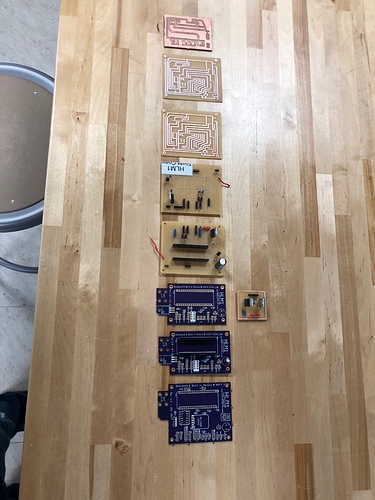Hello everyone.
Just wanted to share a project I am very proud to be a mentor of. Lots of Particle stuff involved 
This report was written by student David Villarreal C.
ASFM - Near Space Program Update
American School Foundation - Humberto Lobo Morales STEM LAB
Monterrey, Mexico
May 1st 2018
A couple months into our Near Space Program, and we’re already gearing up to the fast-approaching late March launch deadline. For the past few weeks, the electronics team has finalized the main flight computer and are focused on finishing up the firmware, the physics team has perfected the parachute and capsule design and the environmental science folks have worked to test our sensors for accurate data collecting, all for it to come together as we finally get ready to let go of our capsule.
Even after accidentally shattering an elementary campus window while testing our parachute system, we’ve continued our pursuit of knowledge and the never-ending improval of our capsule design through experimentation. On Wednesday, March 21st, we performed our first tethered test, letting our capsule climb to 300 meters to simulate ascend and descent conditions, the process of balloon inflation and to test the responsiveness of our sensors. Apart from catching breathtaking GoPro shots of our school from above, we were able to pinpoint flaws in our setup and allowed us to formulate a pre-flight checklist for our launch. Now, as our deadline approaches, we, the Near Space Program Team are finalizing our capsule systems and rechecking our procedures to ensure a successful flight. Our launch window is now on the horizon, and we’re ready to let go.
From the Near Space Program team here at ASFM in Monterrey, Mexico, we want to show our deep appreciation for your indispensable contribution to our work. Getting ready to send a capsule up to 40,000 meters (120,000ft) has proven far more difficult than what we had initially thought, and the learning opportunities have proven invaluable.
We have learned how to design and carve our own PCBs, CNC our own Capsule, Custom design and 3D print parts, calculate and predict flight paths, launch permission requirements, lift calculations, iOS development, C++ firmware programming, and develop countless skills like open source philosophy (we hosted our project on github for anyone to use) but most importantly we have learned that we are now capable of anything!
We have used TeamGantt (http://teamgantt.com) app to track and assign tasks to our 15 members and advisors. It has proven to be an invaluable tool for our team to work, contribute and to track our progress.
We are using Digital Ocean to host the NodeJS server that will gather data from multiple sources such as the satellite modem, particle.io cellular data and a custom receiver based on XBee radios that will send the data to the Digital Ocean cloud server. The server uses websockets to relay that data in real-time to our iOS app (Now in the App Store). We use the app for real-time telemetry and the server combines all sources including satellite, cellular and radio.
As our main flight computer (MCU) we are using the amazing Particle’s Electron (www.particle.io), we use cellular data as backup when we are below 6,000 ft. We predict that when we land the parachute might cover the capsule or worst, the capsule can land upside down and it might be difficult to send data to the iridium satellites. Additionally, we might not have line of sight for reliable RF transmissions, so we have the Electron that makes it easy to have a good and simple cellular backup for recovery. Also the many I/Os provided by the MCU have proven very helpful for our interface: the programming ecosystem and the community is truly amazing.
We still have plenty of challenges ahead that we need to solve before our launch: we have to solve and provide external power to at least one GoPro so that we can record all the flight and still be under our weight limit, we need to calculate accurately all of our helium and lift variables so that we don’t get a floater that will float in the atmosphere forever or an early burst that will not allow us to go all the way up. We are confident that we can make our deadline (crossing fingers).
The evolution of our main flight computer
This is our last carve. After this we went to Oshpark for manufacturing
Thank you for your time!
Our team is very proud of this project. We will keep you posted on our launch progress!
Sincerely,
Near Space Program Team
@ ASFM (HLM StemLab)
http://www.asfmstemlab.com
Project Links:
iOS App: (Alpha)
StemLab WebSite (draft):
https://asfmstemlab.com
GitHub Page:
Instagram Page:
NSP Live Tracking WebSite (Alpha):
http://nsp.asfmstemlab.com
YouTube Channel (Will Broadcast Live):
https://www.youtube.com/channel/UCmRLfc6YSyxyI8WdfrBQE2w
OTHER TOOLS WE USE
Carvey CNC / XCarve
Autodesk Fusion 360
Autodesk Eagle PCB Design Software
Particle.io cloud services / Electron MCU
XBee Radios from Digi
Some components from SparkFun (SD Card Logger, Level Shifters)
Prusa 3D MK2.5 3D Printer
Digital Ocean Cloud Servers
Slic3r STL Slicing Software
FlatCam PCB Carving Software
Affinity Designer (2d Design)
Apple MAC/ iPad / XCode (Swift)
RockBlock Iridium Sat Modem
NodeJS
Glowforge Laser Cutter







